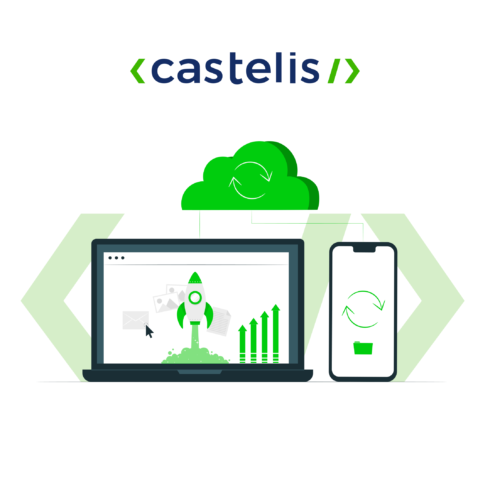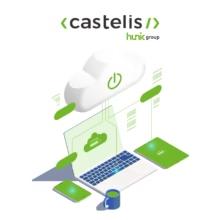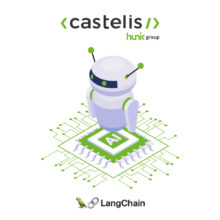
The Benefits of Cloud Migration
Migrating to the cloud is a fundamental step to complete the digital transformation process and become more competitive. But what exactly is cloud computing ? What types of services currently exist ? What are the advantages of the cloud in terms of performance and safety ? Here is what you need to know before starting your cloud migration.
Cloud computing: what is it?
The term cloud computing refers to access to a digital service via a distributed computing architecture on the net. Email, social networks or Video On Demand services are intuitive examples of how it works. The reason is that the emails, messages or videos exchanged are not directly stored on the devices used, but are distributed on demand by external servers.
Cloud technology is therefore based on a physical infrastructure, consisting of servers grouped together in data centers, which power services accessible via the Internet.
The cloud mainly provides two types of use : data storage (cloud storage) and application execution (cloud computing).
Cloud storage solves the problem of limited storage memory, but also provides security services such as duplication of data across multiple data centers, automatic archiving or large-scale content distribution.
Cloud computing allows you to take advantage of large-scale computing capacities made available by operators in an agile manner (on demand); to respond to seasonal issues; and to facilitate collaborative work with all the company’s partners.
Types of cloud services: SaaS, PaaS and IaaS
Cloud technology has broad applications in the B2B domain, where highly specialized solutions are now accessible via the web without the need for local installation. We can identify three main types of service: IaaS, PaaS and SaaS.
Infrastructure as a Service (IaaS)
With Infrastructure as a Service, companies can manage a complete IT infrastructure without it being physically located on their premises. The provider, on the other hand, owns the hardware and offers guarantees in terms of security.
Platform as a Service (PaaS)
Platforms as a Service give developers the cloud tools to build web applications. The PaaS modality thus enables the development and management of custom applications without the cost and complexity associated with purchasing, configuring and managing the hardware infrastructure and other software required for development.
Software as a Service (SaaS)
Software as a service uses a simple internet connection to deliver the chosen application to users and run it directly via a web browser. Salesforce, Google Workspace or Microsoft 365 are widespread examples of software accessible in SaaS mode, often via a paid subscription.
Cloud migration: four benefits for companies
Cloud migration is the process of digital transformation involving a total or partial move to cloud services (SaaS, PaaS or IaaS). This migration generates many benefits for companies that choose to move to the cloud rather than keeping a 100% on-premises infrastructure.
Improved computer performance
Cloud services work with a data center network that offers increased computing performance compared to an enterprise data center. Starting with a significant reduction in network latency. In addition, local data centers typically require significant IT management effort.
The cloud therefore allows IT teams to focus on achieving higher value-added goals.
Scalability of resources within the cloud
The benefits of cloud computing include the ability to scale resources in an extremely flexible manner. For example, IT managers can choose more or less computing power, storage resources and bandwidth. This makes the cloud an essential digital transformation tool to support business growth in a progressive way.
Cost reduction compared to an on-premise infrastructure
The cloud enables a significant reduction in the cost of IT resources. No need to buy hardware and software, set up a data center and mobilize a team of IT experts to manage a complex IT infrastructure. Not to mention the savings on electricity used to power and cool servers.
Strengthening computer security
Many cloud service providers offer a wide range of technologies that improve the cybersecurity situation for businesses. They offer attractive guarantees for IT security, data protection, and compliance with national and European regulations regarding data retention and privacy.
Organize the Cloud migration
As detailed above, cloud migration consists of moving data and applications to a cloud environment. Depending on the infrastructure elements involved, we can identify several types of migration: rehosting, refactoring, replatforming and replacing.
Rehosting
The company chooses to copy and paste all or part of its applications to the cloud. This cloud migration is done without changing the configuration of the infrastructure and with minimal interventions at the software level. This choice is suitable for organizations that are looking for a fast and simplified cloud migration.
Refactoring
Much more radical and complex, it implies a modification of the architecture, even rewrites at the code level, to adapt the applications to the cloud environment. Obviously, this path is longer, but it guarantees full compatibility with the new usage context.
Replatforming
This method involves updating existing applications to run in the new cloud environment, while retaining their functionality.
Replacing
The organization chooses to replace a licensed application and opts for a SaaS model. This is a choice that ensures great flexibility to adapt the functionalities of business critical software, such as ERP or CRM systems.
Migrate to the cloud with Castelis
For large enterprises and small businesses alike, it can be difficult to understand how to organize a Cloud migration. Whatever the challenges, the cloud migration must be consistent, functional and adapted to the actual business needs.
So how do you transform your IT infrastructure? What type of service to choose: IaaS, PaaS or SaaS? Which cloud migration process to choose? To answer these questions, the experts of the Castelis group accompany you through the entire process necessary to complete your migration project : from design, through implementation, to follow-up.
As a Microsoft gold partner, Castelis uses the Microsoft Azure cloud to help you build your new web-based information system. We ensure the governance of your projects, manage the performance and optimize the costs of the infrastructure. Our teams also work with other leading cloud providers such as AWS (Amazon) and GCP (Google).
Do you have a cloud migration project ? Do you want to optimize your existing cloud infrastructure ? Contact our team of experts.
Voir plus de Actualités

Why Microsoft Sentinel is Essential for Cyber Threat Management: A Practical Guide for CIOs

Top best practices to improve email security with DMARC

Cloudflare Zaraz Guide: Manage your third-party scripts at the Edge for better web performance
